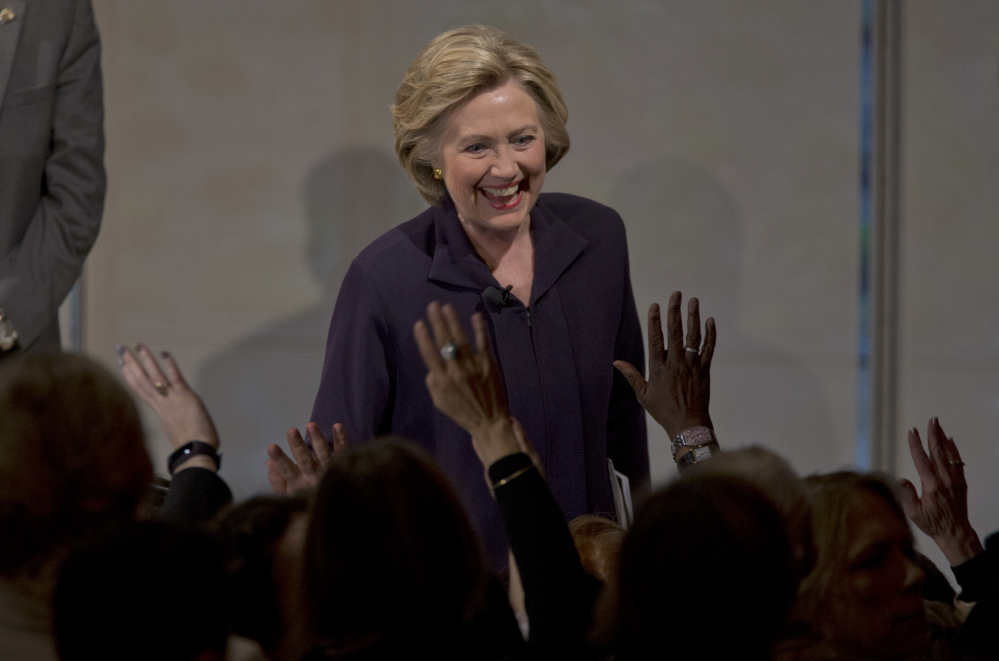When you walk into Hillary Clinton’s national campaign headquarters in downtown Brooklyn, the first thing you see is an unsubtle reminder of the state of the race. There on the wall facing the reception desk is a huge chart, indicating every single pledged delegate and the state in which each was won. There it is, in a series of filled-in blue and pink boxes: Why Clinton will almost certainly be her party’s nominee.
That bit of data hasn’t been universally embraced.
The delegate count is the only tally that matters in determining who will win each party’s nominating contest. It’s always been that way, but over time the selection of those delegates became more democratic. Right now the nomination process exists as a sort of demi-democratic process in which elections were retrofit to work with the internal decision-making processes of each party. So there are still vestiges of weirdness: caucuses, unpledged delegates and superdelegates and the conventions themselves. These are not the way purely democratic elections work.
Which is why some people are skeptical. The New York Times had an article over the weekend detailing the extent to which people think the process is at odds with democracy. It included this paragraph:
“Backers of Sen. Bernie Sanders, bewildered at why he keeps winning states but cannot seem to cut into Hillary Clinton’s delegate count because of her overwhelming lead with ‘superdelegates,’ have used Reddit and Twitter to start an aggressive pressure campaign to flip votes.”
LACK OF UNDERSTANDING
There’s a lot that’s wrong with that understanding and that paragraph that’s worth exploring – which has ripples on the Republican side of the contest, too.
This far into the primary season, both Clinton and Donald Trump have clear, unquestionable leads on that critical metric of pledged delegates. Clinton also has a significant lead with committed superdelegates, mostly party functionaries who can change their minds if they want to. The Republican side doesn’t have superdelegates, as such, but it does have a smaller pool of people who can vote for whomever they want. Most aren’t planning to vote for Trump.
To get the nomination, Clinton and Trump need to hit a delegate total that’s still a bit further down the path, but still in reach for each. In Clinton’s case, she probably won’t get there without superdelegates tilting her way; Trump may not get there if he doesn’t lock down a number of upcoming primary states – starting with New York on April 19.
But that brings us back to the paragraph above. It is not true that Sanders is having trouble catching Clinton “because of her overwhelming lead with ‘superdelegates.’ ” He is having trouble catching her because he trails her badly with pledged delegates (as on that sign at Clinton headquarters), and the states he keeps winning are smaller states with fewer delegates given out.
SANDERS IS SIMPLY WINNING SMALLER STATES
In fact, by every possible democratic measure, Clinton is winning. She’s winning in states (and territories) won, which isn’t a meaningful margin of victory anyway. She’s winning in the popular vote by 2.4 million votes – more than a third more than Sanders has in total. In part that’s because Sanders is winning lower-turnout caucuses, but it’s mostly because he’s winning smaller states. And she’s winning with both types of delegates.
So why is this bewildering? Because it seems like Sanders should be gaining big ground against Clinton – and so “superdelegates” get blamed. Consider two states, though: Oklahoma and North Carolina. Sanders won Oklahoma by 10 points; Clinton won North Carolina by about 13. But Clinton won 14 more delegates than Sanders in North Carolina. He won four more than her in Oklahoma. Because Oklahoma is a smaller state, with fewer Democrats. It’s as simple as that. Where Clinton has won big, there have often been a lot of pledged delegates at stake. Where Sanders has won big, there often haven’t.
CAMPAIGNS NEED PATH TO VICTORY
On the other side, Trump leads with pledged delegates and has a significant edge in terms of raw votes – about 2 million per U.S. Election Atlas’s tally. But he spent the weekend trying to explain away his horrific performance in Colorado by blaming party rules. Trump has a better case for why the process in his party isn’t terribly democratic than does Sanders, but it’s not like he didn’t know the rules going in. Or, at least, that he should have.
Which brings us to another overarching idea that’s worth keeping in mind. It is essential for political campaigns to maintain both a sense of progress and a viable path to victory. To shape how supporters see what’s happening every Tuesday and Saturday.
Trump wants to prepare his supporters for a possible fight at the convention in Cleveland by suggesting that the party has been rigging the path. Sanders has done a good job of convincing supporters that he has a viable path to the nomination, ensuring that his record fundraising will continue unabated. Clinton wants to remind visitors stopping by her office – volunteers and press alike – that she’s winning this thing.
Party nominations are not federal elections. They’re party-run and have a lot of idiosyncrasies as a result. But more voters have voted for the front-runner in each party than for the runners-up. That’s what democratic results are supposed to look like.
The question that’s worth asking is why supporters of trailing candidates think that democracy is being subverted and who benefits from their thinking that. But we’ll leave that to you to assess.
Send questions/comments to the editors.


